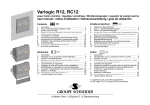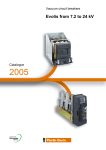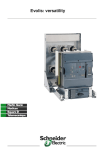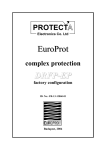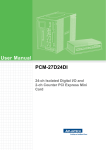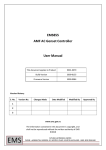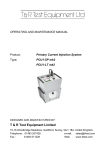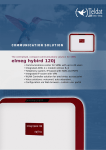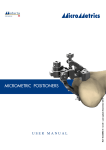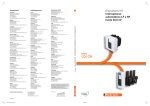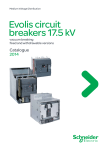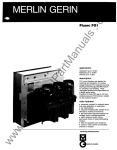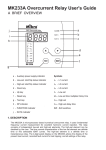Download 0VIP300
Transcript
PCRED399008EN_Couv.FM Page 3 Lundi, 8. novembre 2004 11:41 11 0 0 0 0 0 User manual 2004 Electrical network protection VIP300 Contents Functions and characteristics Presentation of the VIP300 relay 2 Presentation of sensors 3 Description of VIP300 relays 4 Presentation of the VAP6 test unit 8 Using the VAP6 test unit 9 Technical characteristics 10 Installation and connection Mounting 14 Connection 16 1 Functions and characteristics Presentation of the VIP300 relay DE50967 Self-powered protection relay Simplified wiring diagram. The VIP300 relay is designed for use in power distribution systems. It may be used to protect MV/LV transformers, incoming points of industrial installations or branch feeders. The VIP300 provides protection against phase-to-phase faults and earth faults. The choice of tripping curves and multiple settings make is suitable for use in a wide variety of discrimination schemes. The VIP300 is a self-powered relay (supplied by current sensors) requiring no auxiliary power supply. It actuates a Mitop release. The VIP300 is available in three models: b VIP300LL and VIP300P, designed for use with RM6, SFset and Evolis 24 kV circuit breakers v VIP300LL: phase and earth protection v VIP300P: phase protection only b VIP300LH, designed for use with Ringmastercircuit breakers: phase and earth protection with an equivalent time multiplier table on the front to convert settings. DE10332 Phase protection The phase protection has two separately adjustable thresholds: b the low threshold may of the definite time or IDMT type b the high threshold is of the definite time type. The IDMT curves comply with standard IEC 60255-3. They are of the standard inverse, very inverse and extremely inverse types. The low threshold may also be used with the RI curve. Earth protection Earth fault protection is based on residual current measurements using the sum of the sensor secondary currents. Like phase protection, earth protection has two separately adjustable thresholds. Phase and earth fault curves. Equipment description The VIP300 relay is mounted in an injected polycarbonate casing that protects them against dripping water and dusty environments. The front is protected by a transparent cover fitted with a sealing gasket. The cover may be lead-sealed to protect access to the settings. Rotary selector switches are used for setting. The phase and earth fault current settings are set in amperes. This means that the graduations on the front must be adapted to suit the sensor range used. This is done by fitting the appropriate setting label when mounting the relay. The connection is made on the back of the relay using fast-on type connectors. Indication Two indicators show the cause of tripping (phase or earth fault). The indication is maintained even if relay power is cut. Two LEDs (phase and earth) indicate that the low threshold has been overrun and that the time delay is running. 2 Functions and characteristics Presentation of sensors Sensors for VIP300 To obtain the indicated performance characteristics, VIP300 relays must be used with the specified sensors. The relay/sensor assembly is defined to respect the technical characteristics indicated, in particular: b operation over the enitre range b response time b accuracy b short-circuit thermal withstand. The three sensors must be of the same type. Sensors for VIP300LL and VIP300P b CRa 200/1 and CRb 1250/1 sensors are used on RM6 units (models since 1998). b CSa 200/1 and CSb 1250/1 sensors are used on SFset circuit breakers. CSa and CSb sensors have the same number of secondary turns as the CRa et CRb sensors respectively. b CEa 200/1 and CEb 1250/1 sensors are used on 24 kV Evolis integrated circuit breakers (lateral versions). Sensors for VIP300LH b 200/1 and 800/1 are used on Ringmaster circuit breakers. VIP300 sensor input ratings Each VIP 300 has two input ratings corresponding to two different operating ranges. For this reason, the input transformers have an intermediate tapping point on their primary winding. Each tapping point corresponds to a rating with a different operating range. Choosing the right sensor Choose the sensor to be used and the VIP300 connection range in accordance with the desired current setting range. VIP300LL / VIP300P sensors Rating Current setting range CRa, CSa, CEa 200/1 x1 10 A - 50 A x4 40 A - 200 A CRb, CSb, CEb, 1250/1 x1 63 A - 312 A x4 250 A - 1250 A VIP300LH sensors Rating Current setting range Ringmaster 200/1 x2 20 A - 100 A x4 40 A - 200 A Ringmaster 800/1 x2 80 A - 400 A x4 160 A - 800 A For a given operating range, the bottom of the current setting range represents the minimum operating current of the relay. 3 Description of VIP300 relays Phase protection 1. phase overcurrent protection zone 2. threshold overrun indicator 3. phase trip indicator 4. phase current setting Is 5. choice of low threshold curve type 6. low threshold I> 7. low threshold time delay t> 8. multiplying factor (low threshold) 9. high threshold I>> 10. high threshold time delay t>> DE50969 Functions and characteristics Earth protection 11. earth fault protection zone 12. threshold overrun indicator 13. earth trip indicator 14. earth current setting Ios 15. low threshold time delay to> 16. low threshold Io> 17. choice of low threshold curve type 18. multiplying factor (low threshold) 19. high threshold Io>> 20. high threshold time delay to>> Other functions a. setting label b. sensor and range information c. indicator reset d. minimum operating current e. VAP6 test plug f. VIP300LL: tripping curves VIP300LH: equivalent time multiplier table for conversions. DE50970 VIP300LL/VIP300LH front panel. VIP300P front panel. 4 Functions and characteristics Description of VIP300 relays VIP300LL, VIP300LH and VIP300P phase protection DE10324 See also c: indicator reset button. DE10325 Curve 1: phase setting V IDMT low threshold b 1: phase protection setting zone The phase protection settings are located in the top half of the front panel. b 2: threshold overrun indicator When the red indicator blinks, the phase protection low threshold time delay is running. When this is the case, if the current does not decrease, the relay will trip. For IDMT curves (SI, VI, EI), the LED lights up when the current is greater than 1.2 times the current setting Is. For the IDMT curve (RI), it lights up when the current is greater than the Is setting. For the definite time curve DT, it lights up when the low threshold is overrun. b 3: trip indicator It is normally black and turns yellow to indicate that the phase protection has given a tripping order. It stays in the same status, even when the relay is no longer energized. b 4: choice of current setting Is The current setting range depends on the sensor and range used: the selector switch graduations should be adapted to suit the sensor and range using the setting label. b 5: choice of type of low threshold curve v DT: definite time v SI: inverse time v VI: very inverse time v EI: extremely inverse time v RI: specific curve v off: low threshold disabled. b 6: choice of low threshold I> The threshold is a multiple of the current setting. It is only active for definite time thresholds (selector switch 5 set to DT). If the tripping curve is selected with IDMT (selector switch 5 set to RI, SI, VI, EI), the selector switch has no effect. b 7: setting of low threshold time delay t> If the tripping curve is of the definite time (DT) type, the selector switch sets the low threshold time delay. If the curve is of the IDMT type (RI, SI, VI, EI), the value displayed is the tripping time for a phase current equal to 10 times the current setting. b 8: low threshold time delay multiplying factor In the x10 position, the time delay displayed on selector switch 7 is multiplied by 10. b 9: setting of high threshold I>> The high threshold is chosen as a multiple of the current setting. In "off" position, the high threshold is disabled. b 10: setting of high threshold time delay t>> The time delay is set directly in seconds. Phase protection setting The numbers indicated on the curves opposite are those of the phase protection setting switches (refer to the diagram of the front view). Curve 2: phase setting V definite time low threshold Set: b current setting Is (4) b type of low threshold I> curve (5) v IDMT: RI, SI, VI, EI v definite time: DT b low threshold I> (6). This setting is only active if the low threshold curve chosen is of the definite time DT type (curve 2). For the other choices, SI, VI, EI, RI (fig 1), the selector switch is disabled. b low threshold time delay t> (7) and (8) b high threshold I>> (9) b high threshold time delay t>> (10). 5 Functions and characteristics Description of VIP300 relays VIP300LL and VIP300LH earth protection The principle is the same as for phase protection. The earth fault threshold overrun indicator only lights up if the phase current is greater than the minimum operating current. See also c: indicator reset button. b 11: earth protection setting zone The earth protection settings are located in the bottom half of the front panel. b 12: threshold overrun indicator When this indicator blinks, the earth protection low threshold time delay is running. When this is the case, if the current does not decrease, the relay will trip. for IDMT curves (SI, VI, EI), the LED lights up when the current is greater than 1.2 times the current setting Ios. For the IDMT curve (RI), it lights up when the current is greater than the Ios setting. For the definite time curve DT, it lights up when the low threshold is overrun. b 13: trip indicator It is normally black and turns yellow to indicate that the earth protection has given a tripping order. It stays in the same status, even when the relay is no longer energized. b 14: choice of current setting Ios This is the maximum residual current that can flow in the system without the protection being tripped. The Ios current setting range depends on the sensor and range used: the selector switch graduations should be adapted to suit the sensor and range using the setting label. b 15: setting of low threshold time delay to> If the tripping curve is of the definite time (DT) type, the selector switch sets the low threshold time delay If the curve is of the IDMT type (RI, SI, VI, EI), the value displayed is the tripping time for an earth current equal to 10 times the current setting. b 16: choice of low threshold Io> The threshold is a multiple of the current setting. It is only active for definite time thresholds (selector switch 17 set to DT). If the tripping curve is selected with IDMT (selector switch 17 set to RI, SI, VI, EI), the selector switch has no effect. b 17: choice of type of low threshold curve v DT: definite time v SI: inverse time v VI: very inverse time v EI: extremely inverse time v RI: specific curve v off: low threshold disabled. b 18: low threshold time delay multiplying factor In the x10 position, the time delay displayed on selector switch 15 is multiplied by 10. b 19: setting of high threshold Io>> The high threshold is chosen as a multiple of the current setting Ios. In "off" position, the high threshold is disabled. b 20: setting of high threshold time delay t>> The time delay is set directly in seconds. Earth protection setting The principle is the same as for phase protection. Set: b current setting Ios (14) b type of low threshold Io> (17) v IDMT: RI, SI, VI, EI v definite time: DT b low threshold Io> (16). This threshold is only active if the low threshold curve chosen is of the definite time DT type. For the other choices, SI, VI, EI, RI, the selector switch is disabled. b low threshold time delay to> (15) et (18) b high threshold Io>> (19) b high threshold time delay to>> (20) Operation The high and low thresholds operate separately. The tripping order results from a "logical OR" between the two thresholds. 6 Functions and characteristics Description of VIP300 relays Other VIP300LL, VIP300LH and VIP300P functions DE50982 M b a: setting label The setting label should be fitted on the VIP300 when it is mounted on the circuit breaker. The label indicates the graduations of the phase current and earth protection setting selector switches. It is inserted from the top, behind the transparent part of the front panel. Each VIP300 comes with a set of labels. Install the label that matches: b the type of sensor used b the VIP300 model b the range used. Each setting label matches a sensor and is printed on both sides for each of the two ranges. The label may therefore be turned around if the VIP300 range is changed during the service life of the installation. b b: sensor and range indication The text is printed on the setting label. When the label is in position in the slot, the text is hidden by a non-transparent zone. It is not visible to the user. How to fit the setting label DE50975 Minimum operating current: the VIP300 does not operate below the minimum operating current level. As a result, if the earth protections are set below the minimum operating current, they will only take effect when there is phase current greater than or equal to the minimum operating current. b c: indicator reset button The button is accessible when the transparent cover is closed. Pressing the button has two results: v it resets (black position) the two phase and earth trip indicators (when the relay is no longer energized, it is still possible to reset the indicators for about 48 hours; after that time, they may be reset after the VAP6 is plugged in) v it lights up the two red LEDs (about 3 s). This indicates that: - the relay is energized (the indicator lights up when the current is greater than the minimum operating current) - relay self-testing results are OK. If one of the two conditions is not met, the indicators do not light up. This function may be used to carry out a basic relay operation test. b d: minimum operating current The minimum operating current is the phase current required for the relay to be energized and operational. It is printed on each setting label. The value given on the setting label is the three-phase rms minimum operating current. The minimum operating current always corresponds to the the lowest value of the current setting range. b e: VAP6 test plug The test plug is exclusively designed for connection of the VAP6, used for fast and easy relay testing. The test may be carried out during normal operation of the installation since the VAP6 and VIP300 provide the possibility of testing without circuit breaker tripping. b f: tripping curves v VIP300LL/VIP300P v VIP300LH: equivalent time multiplier table for conversions. Testing the VIP300 with the VAP6 7 Functions and characteristics Presentation of the VAP6 test unit DE50916 The VAP6 is a portable unit that is connected to the VIP300 to carry out simplified testing. The test can be carried out in the following two cases: b the VIP300 is already supplied by the sensors. b the VIP300 is not supplied ; in this case, the VAP6 batteries supply power to the relay. The test consists of: b initiating the VIP300 central processing unit self-test sequence b injecting a stimulus to simulate a phase fault b injecting a stimulus to simulate an earth fault b checking tripping. Push-buttons b Battery test: if the batteries are OK, the "on" indicator lights up while the button is pushed. b Phase overcurrent: sends the phase protection test stimulus. The stimulus is equivalent to 20 times the phase current setting Is. b Earth fault: sends the earth protection test stimulus. The stimulus is equivalent to 20 times the earth fault current setting Ios. b Trip inhibition: press the "trip inhibition" button if the VIP300 test should be carried out without tripping of the circuit breaker. Circuit breaker tripping is disabled while the 'trip inhibition" button is pressed, even if the tripping order results from a real fault. Indicators b On: indicates that the batteries are operating. Also lights up when the battery test is carried out by pressing "battery test". b Test in progress: confirms sending of the test stimulus to the VIP300. b Trip: used to test other relays in the VIP range. It should be ignored for the VIP300 test (it lights up for a short time when the VIP300 sends a tripping order, whether or not the circuit breaker is inhibited). VPA6 front panel "external mitop" output It may be used to connect an auxiliary mitop designed, for instance, to stop a stop watch during operating tests. The mitop is triggered at the same time as the circuit breaker mitop. It is not inhibited by pressing the "trip inhibition" button. Batteries The VAP6 is supplied by batteries. Therefore the parts of the VIP300 that require AC current are not checked using this method (input and supply circuits). To conserve battery life, the batteries are normally off and automatically go on when the VAP6 is connected to the VIP300. They go on when: b the "battery test" button is pressed b the VAP6 is connected directly to a VIP3X or VIP5X relay b the VAP6 is connected to the adapter cord designed for testing the VIP1X or VIP2X relays. To install or change the batteries, open the unit by removing the 4 screws on the bottom. Always observe correct battery polarity (+/-). Technical characteristics b supply: 3 x 9 V 6LR61 batteries b weight: 0.45 kg b dimensions: 93 x 157 x 45 mm. 8 Functions and characteristics Using the VAP6 test unit DE50992 VAP6 test sequence The test may be carried out with or without current in the sensors. During the test operations, all the VIP300 settings are effective; the relay should perform in accordance with the settings. During the test, the relay remains operational and will give a tripping order in the event of a fault, unless the "trip inhibition" button is pressed. b Connect the VAP6 to the "VAP6 test plug". The VAP6 batteries automatically go on and the "on" indicator lights up. b Press the VIP300 "reset" button: v if the two "trip" indicators were yellow, they go black v the two red I> and Io> indicators of the VIP300 light up for about 3s to indicate that the central processing unit has correctly performed self-testing. b Press the "trip inhibition" button if the test should be carried out without tripping of the circuit breaker. Be sure to keep the "trip inhibition" button pressed throughout the time it takes to send the stimulus. If the "phase overcurrent" button is held down after tripping, the VIP300 starts the time delay/tripping cycle again; this is normal. In that case: b the VAP6 red "trip" indicator lights up for a short time after each trip b depending on the time delay setting, the VIP300 red "I>" indicator may be off or blink rapidly in an irregular manner. b Press the "phase overcurrent" button to send the phase protection test stimulus: v continue pressing the button throughout the duration of the stimulus (the stimulus represents about 20 times the current setting Is) v the VAP6 "test in progress" indicator lights up to confirm the sending of the stimulus to the VIP300 relay v the red "I>" indicator of the VIP300 blinks during the time delay period v then the VIP300 phase "trip" indicator turns yellow v the circuit breaker trips if it is not inhibited. b Press "earth fault" to test operation of the earth protection. The stimulus injected is equal to 20 times the current setting Ios. Use the same procedure as for the phase protection test. b Disconnect the VAP6. In order to save battery power, do not leave the VAP6 connected to the relay unnecessarily . 9 Functions and characteristics Technical characteristics Phase protection Accuracy Low threshold I> ±5 % or 0/+2 A (1) Low threshold time delay t>definite time ±2 % or ±20 ms (2) (8) class 5, IEC 60255-3 or 0/+20 ms (2) (8) IDMT ±5 % High threshold I>> High threshold time delay t>> ±2 % or ±20 ms Drop-out/pick-up % 95 % Storage time 20 ms (2) Earth protection Low threshold Io> ±5 % or 0/+2 A Low threshold time delay to>definite time ±2 % or ±20 ms IDMT High threshold Io>> classe 5, IEC 60255-3 ou 0/+ 25 ms ±2 % or ±20 ms Drop-out/pick-up % 95 % Storage time 20 ms Continuous thermal withstand Short-time thermal withstand (2) (8) Value 240 A with CRa, CSa or CEa sensor 1500 A with CRb, CSb or CEb sensor 240 A with RMR 200/1 sensor 960 A with RMR 800/1 sensor 25 kA / 1 s with CRa, CRb, RMR 800/1, CSa, CEa, CSb or CEb sensor 25 kA / 1 s with RMR 200/1 sensor on range x2 20 kA / 1 s with RMR 200/1 sensor on range x4 Operating frequency 50 Hz ±10 %, 60 Hz ±10 % Operating temperature –25 °C to +70 °C Storage temperature –40 °C to +85 °C Weight 1.7 kg Minimum operating current VIP300LL/VIP300P + CRa, CSa or CEa sensor VIP300LL/VIP300P + CRb, CSb or CEb sensor VIP300LH + RMR 200/1 sensor VIP300LH + RMR 800/1 sensor Climatic withstand (2) (5) (8) ±5 % High threshold time delay to>> General characteristics (3) (4) (5) Range Value x1 10 A x4 40 A x1 63 A x4 250 A x1 20 A x2 40 A x1 80 A x2 160 A Standard (7) Severity Low temperature operation IEC 60068-2-1 –25 °C, 16 h Low temperature storage IEC 60068-2-1 –40 °C, 96 h High temperature operation IEC 60068-2-2 +70 °C, 16 h High temperature storage IEC 60068-2-2 +85 °C, 96 h Fast changes in temperature IEC 60068-2-14 –25 °C à +70 °C, 5 cycles Operation in damp heat IEC 60068-2-3 56 days, 93 % HR Salt spray IEC 60068-2-52 severity 1 10 Functions and characteristics Technical characteristics Mecanical withstand Standard Severity Vibrations IEC 60255-21-1 class 2 Shocks and bumps IEC 60255-21-2 class 2 Earthquakes IEC 60255-21-3 class 2 Enclosure degree of protection EN 60529 IP54 (cover closed) Fire resistance IEC 60695-2-1 650 °C Standard Severity Electrical withstand Sensor input isolation IEC 60255-5 2 kV rms, 50 Hz, 1 mn 1.2/50 µs impulse voltage IEC 60255-5 5 kV (6) Oscillatory waves - 1 MHz burst IEC 60255-22-1 2.5 kV cm (6) Fast transient bursts IEC 60255-22-4 4 kV common and diff. modes, 5 kHz burst (6) 1.2/50(8-20 µs) hybrid wave IEC 61000-4-5 2 kV, 42 Ω (6) 1 kV dm Electrostatic discharge IEC 60255-22-2 8 kV in air, 6 kV on contact HF electromagnetic field IEC 60255-22-3 30 V/m not modulated, 27 to 1000 MHz EN 50082-2 10 V/m modulated, ampl., 80 to 1000 MHz EN 50082-2 10 V/m modulated, impuls., 900 MHz (1) Value given for three-phase VIP300 power supply. For single-phase operation, the accuracy range is ±10% or 0/+5A. For the low threshold, this does not generally represent a real operating situation. However, it may occur during injection testing carried out with a single-phase supply. The error is mainly due to the non-linearity of the sensors and VIP300 input transformers for low currents; the inaccuracy is accentuated when the relay is only supplied by one phase. (2) The accuracy is indicated for a fault (sinusoidal current) that occurs when the VIP300 is already supplied by the current flowing through the circuit breaker. In the event of closing on a fault, the tripping time may be increased by: b +30 ms at 1.5 Is b +20 ms from 2 Is to 10 Is b +10 ms above 10 Is. (3) Generally speaking, the accuracy ranges of earth protection times and thresholds are indicated for a VIP300 supplied by a current that is greater than or equal to the minimum operating current. The measurement of a threshold for earth protection with a single-phase supply is therefore not significant if the threshold is lower than the minimum operating current. (4) Value given for three-phase VIP300 supply. For single-phase testing, the accuracy is ±10% or 0/+5A. For the low threshold, this may occur when the earth protection is tested with a single-phase supply and no supply by the other phases. (5) Under the following specific conditions: b VIP300LL b with CRa sensor b wired to x1 range b if Ios < 8 A b if three-phase current < 20 A the threshold and time delay characteristics are: b low threshold: ±10 % or 0/+4 A b class not specified. (6) Not applicable to test plug. (7) Accuracy ±10 % or ±1.5 A. The value indicates the guaranteed minimum operating current for three-phase operation. (8) The tripping times indicated do not include the mitop response time that depends on the mechanical load (for no load, its tripping time is less than 5 ms). 11 Technical characteristics IDMT tripping curves Functions and characteristics The curves in this chapter indicate the IDMT low threshold tripping times for the 16 t> (or to>) time delay settings. The phase protection and earth protection curves are the same. The numbers indicated to the right of the curves represent the settings on the t> (or to>) time delay selector switch. DE51247-SI SI curve DE51248-VI VI curve 12 Technical characteristics IDMT tripping curves Functions and characteristics DE51249-EI EI curve RI curve DE51250-RI T(s) 10 1 0,1 0,01 1 10 100 I/Is 13 Installation and connection Mounting Dimensions DE10328 The VIP300 is designed for flush-mounting in rectangular cut-outs in sheet-metal panels with a maximum thickness of 3 mm. 0.3 (*) The 4 holes are required only when mounting the VIP on SFset or Evolis 24 kV circuit breakers. DE10337 VIP300 mounting dimensions. DE50981 Mounting the VIP300 The latch may be put into the vertical position by loosening each of the screws (V) before tightening them. b Insert the VIP300 in the cut-out and correctly position the two bottom pins (E) of the casing on the edge of the panel cut-out. b Tighten the screws (V) on the two mounting lugs accessible via the front after opening the transparent cover. b After tightening, make sure that the latch (N) of each lock (visible on the rear face) is in the vertical position, pressing against the panel. b The hole (P) may be used to lead-seal the relay after the setting label has been fitted and the settings made 14 Installation and connection Mounting Fitting the setting label b Slide the setting label into position behind the transparent part of the front face. b Make sure that the indications at the top of the label (M) match: v the sensor used (sensor) v the VIP300 model v the range used (range). This information is hidden when the label is in position. b Make sure that it is pushed right to the bottom of the slot. b To remove the label, use the hole in the top, if necessary with the help of the tip of a pencil or a screwdriver. DE50982 M Choosing the right setting label recto verso recto verso x1 range x4 range x1 range x4 range DE50984 Setting label for VIP300LL and VIP300P with CRb, CSb or CEb sensors DE50983 Setting label for VIP300LL and VIP300P with CRa, CSa or CEa sensors recto verso recto verso x2 range x4 range x2 range x4 range DE50986 Setting label for VIP300LH with Ringmaster 800/1 sensors DE50985 Setting label for VIP300LH with Ringmaster 200/1 sensors 15 Installation and connection Connection VIP300LL and VIP300LH models Connections are made to the back of the VIP300 via 6.35 mm fast-on connectors. DE50976 Wiring to x1 (or x2) range DE50977 Wiring to x4 range 16 Installation and connection Connection VIP300P model Connections are made to the back of the VIP300 via 6.35 mm fast-on connectors. DE50978 Wiring to x1 (or x2) range DE50979 Wiring to x4 range 17 Notes 18 Notes 19 Notes 20 PCRED399008EN - 51311871EN/A0 - © 2004 - Schneider Electric - All right PCRED399008EN_Couv.FM Page 2 Lundi, 8. novembre 2004 11:41 11 Schneider Electric Industries SAS Postal address: Communication Distribution Electrique 38050 Grenoble cedex 9 - France Tel : +33 (0)4 76 57 60 60 As standards, specifications and designs change from time to time, please ask for confirmation of the information given in this publication. This document has been printed on ecological paper. http://www.schneider-electric.com Design: Ameg Publication: Schneider Electric Printed: ART.20499 11-2004



























